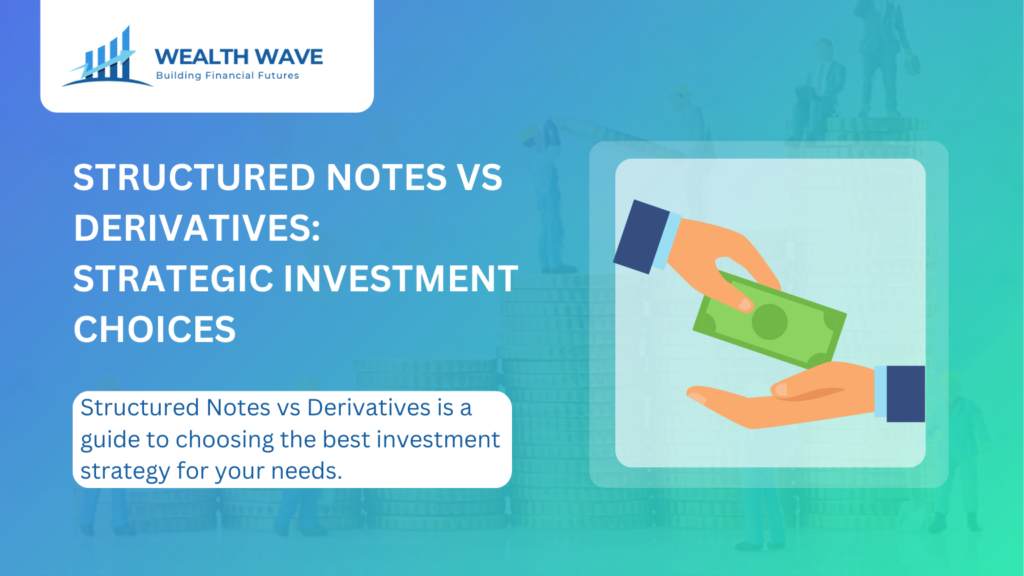
Navigating the investment landscape feels a lot like standing at a crossroads without any clear direction. The plethora of options available, from structured notes to the wide world of financial derivatives, can make your head spin.
Trust us, we’ve been in that exact spot—furrowing our brows and sifting through all the jargon and complex concepts these investments bring to the table.
But don’t worry, we’ve taken the plunge into the investment universe for you and came back with some illuminating insights. It turns out structured notes are actually a type of derivative themselves; they mirror the value of other assets but come with their own set of perks, such as principal protection that combines elements of bonds and derivatives.
Our guide is crafted to demystify these intricate financial tools by drawing a direct comparison between structured notes vs derivatives. You’ll get to understand how they function, weigh their risks against costs, and figure out which one could be a more strategic fit for steering your investment portfolio effectively.
So, let’s start peeling back the layers on this mystery together, shall we?
Key Takeaways
- Structured notes are hybrid investments that mix features of bonds and derivatives to offer variable payments, sometimes with principal protection. They track the value of another asset while aiming to reduce risk through a blend of fixed income and derivative elements.
- Derivatives stand alone as contracts whose values come from underlying assets like stocks or commodities. They’re used for hedging against risks or speculating on future price movements, offering investors leverage and flexibility but also higher potential for losses due to market volatility.
- The main differences between structured notes and derivatives lie in their structure and intended use. Structured notes provide a prepackaged investment option that can include built-in safety features, whereas derivatives offer more direct exposure to underlying asset performance with greater risk-reward potential.
- Investors face various costs and risks when investing in structured notes vs derivatives. While structured products may have higher fees due to their complexity, derivatives expose investors to market fluctuations directly. Understanding these instruments’ pricing structures is essential for managing investment expenses effectively.
- Making an informed choice between structured notes and derivatives requires careful consideration of one’s financial goals, risk tolerance, and the specific characteristics of each product type. Both options cater to different needs within an investment portfolio by offering distinct pathways toward achieving diverse financial outcomes.
Understanding Structured Notes and Derivatives

Structured notes and derivatives serve different financial purposes. They offer unique features that can help us reach our investment goals.
Definition of Structured Notes and Derivatives

Structured notes are a type of hybrid security that combines features of bonds and derivatives. They typically involve pre-packaged investments containing assets linked to interest and one or more derivatives.
Investors in structured notes can benefit from variable payments, which may include combinations of interest, derivatives, and other structured elements. On the other hand, derivatives are financial instruments whose value derives from an underlying asset or index, such as options and futures contracts.
Both structured products and derivatives serve as important investment vehicles for our risk management strategies, offering unique opportunities tailored to suit different investment goals.
Key Differences Between Structured Notes and Derivatives

Both structured notes and derivatives offer unique features to investors, but they serve different purposes. Structured notes are a type of prepackaged investment that combines fixed income products, such as bonds, with one or more derivatives.
This hybrid characteristic allows them to track the value of another asset while potentially providing principal protection. On the other hand, derivatives themselves are contracts whose value is derived from an underlying asset—ranging from options and futures to credit default swaps.
We see that structured notes often include variable payments based on various interest-linked assets and market performance. In contrast, derivatives can be utilized independently for hedging strategies or speculative investments without necessarily being tied to fixed income investments like bonds.
Understanding these key differences enables us to choose between customized investments that fit our financial goals effectively.
How Structured Notes Work

Structured notes combine different financial products to create unique investment opportunities. They often link the return on investment to various assets, which can include stocks or bonds.
Basic Components of Structured Notes
Structured notes consist of key components that create their unique investment features. A structured note typically combines a bond with one or more derivatives, forming a hybrid security.
This combination allows structured notes to offer variable payments linked to interest rates and other performance metrics. These pre-packaged investments incorporate elements from various assets, making them flexible for different market scenarios.
We can categorize the basic structure into principal protection and variable returns. Structured notes with principal protection ensure that we receive our initial investment back at maturity, while the return on investment depends on the performance of underlying benchmarks or indices.
Understanding these components helps us navigate how they function as both bond investments and derivative products in structured finance. Next, we’ll explore how derivatives operate in this context.
How the Return on Investment is Calculated
The return on investment for structured notes is calculated based on the performance of the underlying assets linked to interest and derivatives. We examine factors such as the bond component’s yield and any variable payments that may arise from derivatives included in the structure.
This hybrid security often combines multiple payoffs, allowing us to assess our potential gains more accurately.
For example, if a structured note includes a derivative tied to stock market performance and guarantees principal protection, we analyze how well that underlying asset performs over time.
The final payout depends not only on interest-linked assets but also on how effectively this combination meets our investment objectives. Understanding these components ensures we make informed decisions about investing in these complex products.
Potential Risks Associated with Structured Notes
Structured notes carry potential risks that we must consider. They are hybrid securities combining features of bonds and derivatives, which adds layers of complexity. One significant risk is the issuer’s credit risk.
If the bank that issues a structured note faces financial trouble, our investment could suffer. Additionally, structured notes may involve variable payments based on interest-linked assets and other factors, making it difficult to predict rate of returns accurately.
Another concern is liquidity risk. Structured products can be harder to sell than traditional investments like stocks or bonds; their market may not always be active, leading us to hold onto them longer than intended.
Lastly, while structured notes can offer principal protection through a combination with a bond and derivative elements, this protection isn’t guaranteed in extreme market conditions or if the issuer defaults on its obligations.
Understanding these aspects helps us navigate the landscape of structured notes more effectively as we evaluate our investment options alongside derivatives.
How Derivatives Work

Derivatives are contracts that derive their value from an underlying asset. They include options and futures, allowing us to speculate on price movements or hedge against risks in the market.
Definition of Derivatives
Derivatives are financial contracts whose value is based on the performance of an underlying asset. They can include various forms, such as options and futures, each designed to meet specific investment needs.
Often, we see derivatives used for hedging risks or speculating on price movements in the market. Unlike structured notes that combine features of bonds and derivatives into a single product, derivatives stand alone as distinct financial instruments.
At their core, derivatives serve as tools to manage risk or create leveraged opportunities in our investment strategies. Structured products often utilize these derivatives within their frameworks to enhance potential returns or protect investments.
Understanding how these complex instruments work allows us to make informed decisions when considering options trading or other investment products like collateralized debt obligations and synthetic assets.
Different Types of Derivatives (Options, Futures, etc.)
Derivatives serve various purposes in finance, with options and futures being among the most common types. Options provide us the right to buy or sell an asset at a predetermined price before a specific date.
This flexibility allows us to hedge against potential losses or speculate on market movements. Futures contracts, on the other hand, obligate us to buy or sell an asset at a predetermined price on a specified future date.
These agreements can be useful for managing risk related to price fluctuations.
Structured notes often incorporate these derivatives in their design. They combine features of bonds and derivatives into hybrid securities that track the value of another product while offering unique payoffs based on underlying assets.
Understanding how structured notes relate to different types of derivatives gives us clarity about our investment choices and helps us weigh our options effectively.
Performance and Cost Considerations

When we compare structured notes and derivatives, performance can vary greatly. Costs also play a key role in our investment choices, influencing potential returns and overall strategy.
Comparing the Performance of Structured Notes and Derivatives
Structured notes and derivatives serve different purposes in the investment landscape. Structured notes are hybrid securities that combine features of bonds and derivatives, which allows for a unique performance profile tailored to specific market conditions.
Their returns can include variable payments linked to interest rates, making them suitable for investors seeking some level of principal protection while still gaining exposure to potential market upside.
Derivatives, on the other hand, encompass various forms such as options and futures without necessarily offering built-in protection against losses. While structured notes often come with a level of safety due to their bond component, derivatives can provide more direct leverage and flexibility.
Ultimately, comparing structured notes vs derivatives requires understanding our investment goals and risk tolerance as both have distinct performance characteristics that cater to varying investor needs.
Cost Implications for Investors
Investors face various cost implications when dealing with structured notes and derivatives. Structured products, being pre-packaged investments, often come with higher fees compared to traditional investments like bonds.
These costs include management fees, transaction expenses, and the inherent costs tied to the underlying assets linked to interest. The complexity of structured notes can make their pricing opaque, which may lead to unforeseen charges for investors.
In contrast, derivatives such as options and futures typically have more straightforward pricing structures but carry risks related to fluctuations in market value. Understanding these financial instruments helps us gauge our overall investment strategy.
Balancing the potential returns against these costs is crucial for making informed decisions about whether structured notes or derivatives best suit our needs as investors.
Risks of Structured Notes and Derivatives

Structured notes and derivatives come with their own sets of risks. We face potential downsides that can affect our investment outcomes and must consider various factors before deciding to invest in either option.
Potential Risks and Downsides of Both Structured Notes and Derivatives
Structured notes carry significant risks despite their appeal as prepackaged investments. They often involve variable payments combining interest linked assets and derivatives, making their returns unpredictable.
If the underlying asset performs poorly, we may not recoup our initial investment, especially with structured notes lacking principal protection. Additionally, complexities arise from the hybrid nature of these products; understanding all components can prove challenging.
On the other hand, derivatives pose different challenges. Their value is derived from other financial instruments like stocks or commodities, which can experience high volatility. This can lead to substantial losses if market conditions change unexpectedly.
The use of options and futures adds layers of risk that may overwhelm some investors who are not familiar with such instruments. Both structured products and derivatives require careful consideration before investing due to these inherent risks and potential downsides.
Important Factors to Consider Before Investing in Either
Investors must consider several important factors before investing in structured notes or derivatives. Structured notes combine features of bonds and derivatives, leading to a unique investment experience.
They often involve variable payments that incorporate interest and other structured elements, making their performance complex. Understanding the specific components of these products is crucial.
We should also evaluate risks associated with both investments. Structured notes can carry potential downsides similar to other financial instruments, but they offer principal protection when combined correctly with bonds.
Derivatives come with their own set of challenges based on market volatility and liquidity concerns. Thus, we need to assess our risk tolerance and investment objectives before proceeding with either option.
Conclusion

Structured notes and derivatives offer unique pathways for investment. We explored their definitions, functions, and how they interact within the financial market. Understanding these instruments allows us to navigate potential risks while maximizing returns efficiently.
By leveraging both structured notes’ hybrid characteristics and the flexibility of derivatives, we can enhance our investment strategies significantly.
For those eager to learn more about these opportunities, numerous resources are available, providing deeper insights into each option. Let’s take bold steps in our investing journey together!
FAQs
Q1. What are structured notes?
Ans. Structured notes are financial products that combine a bond with a derivative to earn returns based on market performance.
Q2. How do derivatives differ from structured notes?
Ans. Derivatives are contracts that derive their value from an underlying asset, while structured notes also include a bond component and offer potential for higher returns.
Q3. Can you explain why these financial tools can be complicated?
Ans. These tools can seem complicated because they involve complex calculations of risk and return tied to the performance of different assets in the market.
Q4. Is it risky to invest in derivatives or structured notes?
Ans. Investing in either can carry risks due to their complexity and dependence on market factors, so it's crucial to understand them fully before making an investment decision.




